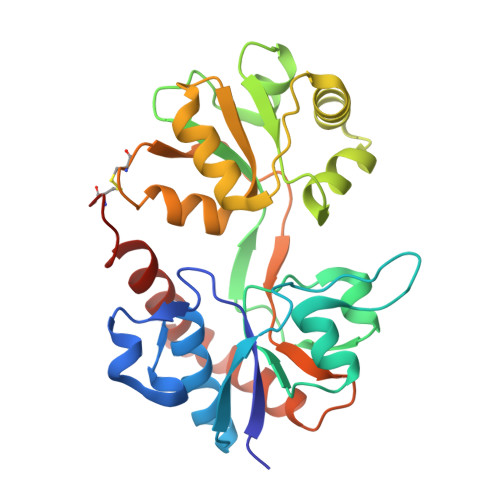Structure-Activity Relationship Study of Ionotropic Glutamate Receptor Antagonist (2S,3R)-3-(3-Carboxyphenyl)pyrrolidine-2-carboxylic Acid.
Krogsgaard-Larsen, N., Storgaard, M., Moller, C., Demmer, C.S., Hansen, J., Han, L., Monrad, R.N., Nielsen, B., Tapken, D., Pickering, D.S., Kastrup, J.S., Frydenvang, K., Bunch, L.(2015) J Med Chem 58: 6131-6150
- PubMed: 26200741
- DOI: https://doi.org/10.1021/acs.jmedchem.5b00750
- Primary Citation of Related Structures:
4YMA, 4YMB - PubMed Abstract:
Herein we describe the first structure-activity relationship study of the broad-range iGluR antagonist (2S,3R)-3-(3-carboxyphenyl)pyrrolidine-2-carboxylic acid (1) by exploring the pharmacological effect of substituents in the 4, 4', or 5' positions and the bioisosteric substitution of the distal carboxylic acid for a phosphonic acid moiety. Of particular interest is a hydroxyl group in the 4' position 2a which induced a preference in binding affinity for homomeric GluK3 over GluK1 (Ki = 0.87 and 4.8 ¦̀M, respectively). Two X-ray structures of ligand binding domains were obtained: 2e in GluA2-LBD and 2f in GluK1-LBD, both at 1.9 ? resolution. Compound 2e induces a D1-D2 domain opening in GluA2-LBD of 17.3-18.8¡ă and 2f a domain opening in GluK1-LBD of 17.0-17.5¡ă relative to the structures with glutamate. The pyrrolidine-2-carboxylate moiety of 2e and 2f shows a similar binding mode as kainate. The 3-carboxyphenyl ring of 2e and 2f forms contacts comparable to those of the distal carboxylate in kainate.
Organizational Affiliation:
?Chemical Neuroscience Group, ?Biostructural Research Group, ¡́Medicinal Chemistry Group, ¡ÎMolecular, Cellular Pharmacology Group, Department of Drug Design and Pharmacology, Faculty of Health and Medical Sciences, University of Copenhagen, Universitetsparken 2, 2100 Copenhagen ?, Denmark.





















